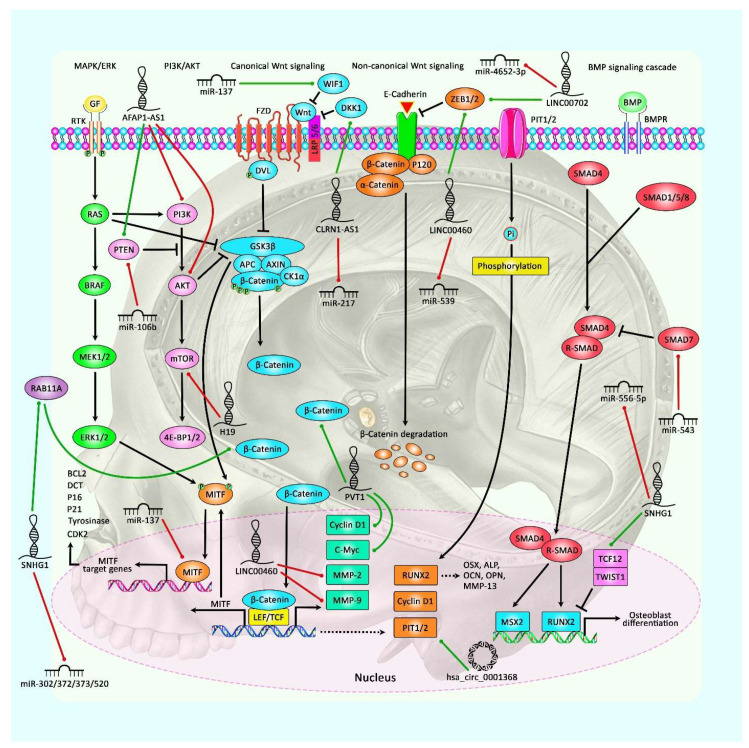Figure 1.
A schematic representation of the role of several non-coding RNAs in regulating the MAPK/ERK, PI3K/AKT, Wnt/β-Catenin, and BMP signaling pathways in pituitary gland tumors and meningiomas. The figure represents the potential crosstalk between various signaling cascades modulated via several ncRNAs in triggering the development of tumor cells. WNT-signaling is a crucial part of the crosstalk between key oncogenic cascades involved in pituitary gland tumors. Elements of the WNT cascades both could be regulated through diverse pathways, including MAPK/ERK, PI3K/AKT, and BMP, as well as transcriptional regulators containing p53 and MITF [32]. In addition, an accumulation of β-catenin in the cytoplasm could, in turn, lead to its translocation to the nucleus, where it could create a complex with TCF/LEF to trigger the transcription of RUNX2, Cyclin D1, and PIT1/2. Additionally, RUNX2 could modulate the transcription of various targets, including OCN, OSX, OPN, MMP13, and ALP [33]. Furthermore, BMP receptors could phosphorylate receptor-SMADs upon ligand binding. TCF12 and TWIST1 are basic helix-loop-helix transcription factors that could play an effective role in heterodimerization and suppressing transcription downstream of the BMP cascade [34]. According to the current report, lncRNA AFAP1-AS1 could enhance growth and inhibit apoptosis in pituitary adenomas through promoting PTEN expression and suppressing the expression levels of PI3K and AKT in tumor cells [29]. Moreover, another research has denoted that LINC00460 could elevate meningioma progression and metastasis through promoting the expression levels of MMP-2, MMP-9, and ZEB1 by sponging miR-539 and thereby acting as an oncogenic RNA in the meningioma malignancy [35]. Moreover, based on recent study, lncRNA SNHG1 via targeting miR-556-5p could elevate TCF12 expression, thereby promoting tumorigenesis of meningioma through the Wnt signaling cascade. In fact, TCF12 expression was positively modulated via SNHG1, and TCF12 could, in turn, enhance transcription of SNHG1 through binding with the promoter region of SNHG1 [36]. Green arrows indicate the upregulation of target genes modulated via ncRNAs (miRNAs and lncRNAs); red arrows depict inhibition regulated by them. All the information regarding the role of these ncRNAs in modulating pituitary gland tumors can be seen in Table 1, Table 2, Table 3, Table 4 and Table 5.

